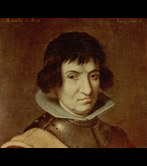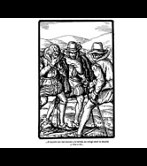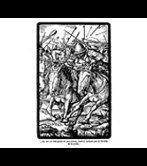Catalina de Erauso
The woman known as the second lieutenant nun was born in Donostia at the end of the 16th century, in 1592. As she was not among the main family heirs, inevitably, she entered a convent. However, Catalina ran away from the Antiguo Dominican convent when she was around 15 and, dressed as a boy, began one of the most incredible adventures of 17th-century Gipuzkoa.
Passing herself off as a pageboy, she worked for the king’s secretary, Juan de Idiakez, a friend of her father and also for her own aunt in Donostia, who clearly didn’t recognize her. However, the adventures for which she will always be remembered began when she went to America, where she made contact with the wide network of Basque families. She started working for the merchant Juan de Urkizu.
Her swordplay and a habit of dealing with offenders in this manner meant that she had to flee to Lima where she joined the army to fight the Araucanians. Once again she was helped by the Basque social network and was even looked after by her own brother, who thought she was a relative but didn’t recognize her, a further demonstration of the broad and inclusive concept of family at the time.
She was famously warrior-like, both in battle and in duels and arguments. Having risen to the rank of second lieutenant at the battle of Valdivia, she had to flee once again, having murdered her own brother in a nighttime duel, in which both took part as seconds. She crossed the Andes to Tucumán, and a journey that in itself says something about her strength and determination. From there she escaped once again, having broken a promise of marriage to two separate women. Fights, battles, death sentences and escapes followed her all around the Cono Sur until she reached Cuzco, after killing a sword fighter. Seriously wounded and believing she was close to death, she admitted that she was a woman.
She always protected by the Basque social network in America and was to Bishop Guamanga that she made the public confession of her true sex. The case was followed with interest in America and Europe. She once again donned the habit and entered the Santa Clara convent until the death of her protector, Guamanga, in 1620. Then, summoned by the Archbishop of Lima, she was received by an enormous crowd there and entered the Santísima Trinidad convent. She returned to Europe, after several more fights on the high seas, in 1624. She was received by the King and by Pope Urbano III, who gave his permission for her to continue her life dressed as a man as long as she moderated her excesses. She returned to America in 1645 under the name of Antonio de Erauso and died suddenly in 1650 in either Ayacucho or Quitlaxtla. Francisco de Loiola, Alonso Díaz Ramírez de Guzmán and Antonio de Erauso were three of the men’s names she used during her life.




